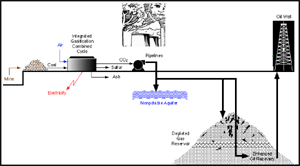|
Modeling CO2 Sequestration in Underground Reservoirs
Carbon Dioxide released during fossil fuel consumption is a major source of greenhouse gases.
In order to manage the future climatic changes, the CO2 must be removed from
the flue gas and be permanently stored. The Kyoto protocol has made reducing CO2
emission in order to control the overall levels of carbon dioxide in the atmosphere an international priority.
Several methods for CO2 sequestration in the ocean floor and in geological formations have been
proposed. The sequestration in geological formations including depleted oil and gas reservoirs, coal
seams, and deep brine-fields have been studied. Among these, pumping CO2 into
reservoirs has been exploited commercially in the US for enhanced oil recovery. A schematic of the
CO2 sequestration for enhanced oil recovery is shown in Figure 1.

Figure 1. A schematic diagram of CO2 sequestration and enhanced oil recovery
Recent studies of the use of CO2 for oil recovery were reported by Hattenbach et al. (1999) and
Holloway et al (1996). Lawrence Berkeley laboratory developed a general purpose reservoir
simulator,TOUGH2 (1999), for solving subsurface flow using a finite volume method. Slattery (1972)
and Kaviany (1995) described models for flow and heat transfer in porous media using
volume-averaging techniques.
Objectives
The general objective of this project is to develop a computational tool for modeling the CO2
sequestration processes in underground reservoirs. The specific objectives are:
- To develop a realistic model for two-phase gas-liquid flows in underground reservoirs.
- To develop a physical model for predicting the relative permeability in practical application.
- To analyze process of CO2 sequestration in depleted oil reservoirs.
- To provide a detailed understanding of the enhanced oil recovery through CO2 injection.
- To predict the CO2 sequestration and oil recovery enhancement for several realistic reservoir scenarios.
Preliminary Study
Preliminary results for gas flow in a fractured reservoir is obtained. It is assumed that the fractured regions in the
reservoir have lower permeability. Sample results are shown in Figure 2.

Figure 2. Sample velocity field in a fractured reservoir.
Plan of Study
For the preliminary results shown in Figure 2 the FLUENT Code was used in the analysis. The
treatment of porous media is rather elementary in the FLUENT Code. In addition, the code can not
handle multiphase flows in porous media. We plan to make use of the TOUGH2 code for in the
present study. This code which was developed at Lawrence Berkeley Laboratory is a multi-purpose
reservoir simulator and can handle multiphase flows. The developed formulation will be incorporated in
the TOUGH2 code. The modified code will then be used for studying CO2 sequestration in underground
reservoirs and oil recovery enhancement.
References
Hattenbach, R.P., Wilson, M., Brown, K. (1999), Capture Of Carbon Dioxide From Coal
Combustion And Its Utilisation For Enhanced Oil Recovery, in Greenhouse Gas Control Technologies,
Elsevier Science, New York.
Holloway, S., Heederik, J.P., van der Meer, L.G.H., Czernichowski-Lauriol, I., Harrison, R.,
Lindeberg, E., Summerfield, I.R., Rochelle, C., Schwarzkopf, T., Kaarstad, O., Berger, B. (1996), The
Underground Disposal Of Carbon Dioxide, British Geological Survey, Keyworth, Nottingham, U.K.
Kaviany, M. (1995) Principles of Heat Transfer in Porous Media,
Spring-Verlag, New York.
Lawrence Berkeley Lab., (1999) TOUGH2, Berkeley, CA.
Slattery, J.C. (1972) Momentum, Energy, and Mass Transfer in Continua,
McGraw-Hill, New York.
Wong, S., Foy, C., Gunter, W. D., Jack, T. (1999),
Injection Of CO2 For Enhanced Energy Recovery: Coalbed Methane
Versus Oil Recovery. in Greenhouse Gas Control Technologies,
Elsevier Science, New York.
Funded by US Department of Energy, National Energy Technology Laboratory (NETL)

|























